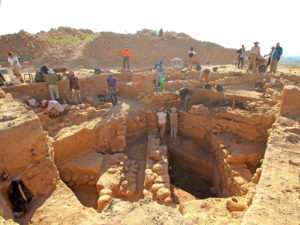As part of a new, multi-part series, we will explore some of the more interesting archeological and historical evidence that supports the truth of the Bible. While we have touched on this topic in other articles (here and here), we are taking a more comprehensive look and covering specific discoveries since the Bible’s credibility is so often questioned by critics.
Initially, the focus will be on establishing the general accuracy and reliability of the biblical texts. Once a solid foundation is laid, we will shift attention to some of the more “fantastic” or questioned stories that are often challenged by critics. Examples include the rise of Joseph within Egypt, Israel’s subsequent migration and enslavement, the divine plagues pronounced on pharaoh, the Exodus of the Jews, the miraculous conquest of Jericho, and the resurrection of Jesus. If compelling historical and archeological evidence supports both the Bible’s overall reliability as well as the supernatural stories it contains, the critic has very little remaining basis for questioning its status as a special and unique revelation from God.
Understanding the Challenge
When using ancient history and archaeology to assess the credibility of the Bible, we must keep a few key points in mind. First, we must realize that well over 99.9% of the historical documents and evidence from the ancient past simply no longer exist. Therefore, very few facts can be established with certainty. There is often room for interpretation if not outright error. Consequently, the same information can be used by different historians to argue different theories. And what does exist often reflects the same human biases and opinions that are seen today in different media outlets. We must therefore take what we do have and make logical inferences about what we don’t have.
We can sometimes determine whether an ancient event is true or false if it is validated by multiple, otherwise trustworthy sources. More often, though, the best one can do is determine if a particular incident is feasible and/or consistent with known facts from a given period. For this reason, much of the ancient past (biblical or otherwise) is debated and we must understand that reality. Despite this challenge, archaeology can still provide a tremendous amount of insight into the Bible and help us make determinations about its underlying credibility.
Building the Foundation
Overall, the Bible has a strong record of reliability in the areas where it can be validated. There have been over 25,000 archaeological sites in biblical lands1 and they have shown remarkable consistency with biblical claims. Hundreds of names, places, events, and cultural practices mentioned in the Bible have been verified by historical and archeological analysis. In fact, in many cases where historians originally accused the Bible of being in error, subsequent findings have validated it and silenced the critics.
Noted historians and archaeologists have commented on the Bible’s historical accuracy:
“It may be stated categorically that no archaeological discovery has ever controverted a biblical reference.” Nelson Glueck, renowned Jewish archaeologist2
“There can be no doubt that archaeology has confirmed the substantial historicity of the Old Testament tradition.” Dr. Millar Burrows3 of Yale, a leading scholar on the Dead Sea Scrolls
“The excessive skepticism shown toward the Bible by important historical schools of the eighteenth- and nineteenth centuries, certain phases of which still appear periodically, has been progressively discredited. Discovery after discovery has established the accuracy of innumerable details and has brought increased recognition to the value of the Bible as a source of history.” WF Albright, renowned archaeologist4
“Luke is an historian of the first rank; not merely are his statements of fact trustworthy…this author should be placed along with the greatest of historians…Luke’s story is unsurpassed in respect of its trustworthiness.” Sir William Ramsay, famous Scottish archaeologist5
Logically, if the Bible has been repeatedly confirmed in the areas where we can verify it, we should give it the benefit of the doubt in those areas that have not yet been validated. To evaluate its historical credibility, in addition to the discoveries we have covered in previous articles, this series will examine some of the archaeological and historical evidence related to the below questions:
- Did Moses actually write the Pentateuch?
- Is there any evidence for the Old Testament prophets?
- Was King David a real, historical person?
- Were Sodom and Gomorrah supernaturally destroyed by God as judgment for sin?
- Is there any evidence Joseph existed and rose to power in Egypt?
- Were the Jews enslaved in Egypt until God miraculously delivered them?
- Did God help the Israelites conquer Jericho as described in the Bible?
- Did Jesus rise from the dead?
Ultimately, the facts will show there is significant evidence to support even these often challenged biblical claims. Also keep in mind that, while we will cover a lot, there is a tremendous amount of other, interesting discoveries we simply won’t have time to address. Stay tuned for part 2!
Notes:
- Geisler, Norman and Holden, Joseph M. The Popular Handbook of Archaeology and the Bible. Harvest House Publishers 2013. Pg. 74
- McDowell, Josh. The New Evidence that Demands a Verdict. Thomas Nelson 1999. 61
- Ibid, Pg. 372
- Ibid, Pg. 61
- Ibid, Pg. 61

